Experimental Study of the Freeze–Thaw Damage of Alpine Surface Coal Mine Roads Based on Geopolymer Materials
Abstract
:1. Introduction
2. Materials and Methods
2.1. Road Material
2.2. Slag and Fly Ash
2.3. Alkali Stimulant
2.4. Mixing, Pouring, Curing and Maintenance
2.5. Test Methods and Procedure
3. Results
3.1. Mechanical Properties at Different Freezing Temperatures
3.2. Mechanical Properties at Different Number of Cycles
3.3. Microstructural Changes under Freeze–Thaw Damage
4. Discussion
4.1. Under Different Freezing Temperatures
4.2. Under Different Cycle Times
4.3. Microstructure Changes
5. Conclusions
- (1)
- With the decrease in freeze–thaw freezing temperature, the strength of the specimen follows a pattern of initially decreasing and then stabilizing. The uniaxial compressive strength decreased from 21.62 MPa to 13.19 MPa after fitting a quadratic curve and subjecting it to a freeze–thaw cycle at −35 °C. This represents a strength reduction of 61%. Similarly, the tensile strength decreased from 2.43 MPa to 1.19 MPa after fitting a quadratic curve and subjecting it to the same freeze–thaw cycle. This represents a strength reduction of 49%, which is greater than the loss in uniaxial compressive strength.
- (2)
- With an increase in the number of freeze–thaw cycles, the strength of the specimen showed a linear decrease according to the law of change. The uniaxial compressive strength after fitting was found to be a linear function of reduction. From no freeze–thaw, the strength reduced from 21.62 MPa to 11.63 MPa, resulting in a discount of 54%. Similarly, the tensile strength after fitting was also a linear function of reduction. It decreased from 2.43 MPa to 1.09 MPa, resulting in a discount of 45%. This discount is greater than the loss of uniaxial compressive strength.
- (3)
- With an increase in the number of freeze–thaw cycles, the internal structure of the specimen gradually becomes looser, transitioning from dense to loose. The fracture mode changes from ductile fracture to perforation fracture and then to along-crystal fracture. Additionally, the magnitude of energy dissipation at the time of destruction gradually decreases, resulting in a decrease in the maximum load at the time of destruction. The main elements also change from O, Si, and Al under no freeze–thaw conditions to O, Ca, and Si after freeze–thaw. This change is attributed to the high content of CaO in the slag and the high content of Al2O3 in fly ash. It is possible to achieve a reduction in strength of up to 45%, which is greater than the loss of uniaxial compressive strength. Based on the Al2O3 content, it can be concluded that the rupture area of the specimen before freezing and thawing is primarily caused by fly ash agglomeration. However, after freezing and thawing, the rupture area is mainly due to slag agglomeration. This indicates that slag is more susceptible to the detrimental effects of freezing and thawing compared to fly ash.
Author Contributions
Funding
Data Availability Statement
Acknowledgments
Conflicts of Interest
References
- Thompson, R.; Visser, A.; Miller, R.; Lowe, T. Development of real-time mine road maintenance management system using haul truck and road vibration signature analysis. Transp. Res. Rec. 2003, 1819, 305–312. [Google Scholar] [CrossRef]
- Xu, X.; Zhang, J.; Yang, R. Structure and properties of alkali-inspired ground polymer cementitious building materials. J. Ezhou Univ. 2011, 18, 45–48. [Google Scholar]
- Huang, K.; Ma, Y.; Guo, Y.; Li, Z. Properties of Alkali-activated Fly Ash/Slag Composite System. Bull. Chin. Ceram. Soc. 2015, 34, 2769–2774. [Google Scholar] [CrossRef]
- Madhav, T.V.; Reddy, I.V.R.; Ghorpade, V.G.; Jyothirmai, S. Compressivestrength study of geopolymer mortar using quarry rock dust. Mater. Lett. 2018, 231, 105–108. [Google Scholar] [CrossRef]
- Kawalec, J.; Grygierek, M.; Koda, E.; Osinski, P. Lessons Learned on Geosynthetics Applications in Road Structures in Silesia Mining Region in Poland. Appl. Sci. 2019, 9, 1122. [Google Scholar] [CrossRef]
- Segui, P.; Safhi, A.e.M.; Amrani, M.; Benzaazoua, M. Mining Wastes as Road Construction Material: A Review. Minerals 2023, 13, 90. [Google Scholar] [CrossRef]
- Hu, Y. Mechanical and High Temperature Resistance Properties of Fly Ash Geopolymer. Master’s Thesis, China University of Mining and Technology, Xuzhou, China, 2017. [Google Scholar]
- Patel, Y.J.; Shah, N. Development of self-compacting geopolymer concrete as a sustainable construction material. Sustain. Environ. Res. 2018, 28, 412–421. [Google Scholar] [CrossRef]
- Cao, Y.F.; Tao, Z.; Pan, Z.; Wuhrer, R. Effect of calcium aluminate cement on geopolymer concrete cured at ambient temperature. Constr. Build. Mater. 2018, 191, 242–252. [Google Scholar] [CrossRef]
- Davidovits, J.; Huaman, L.; Davidovits, R. Ancient geopolymer in south-American monument. SEM and petrographic evidence. Mater. Lett. 2019, 235, 120–124. [Google Scholar] [CrossRef]
- Celik, A.; Yilmaz, K.; Canpolat, O.; Al-Mashhadani, M.M.; Aygörmez, Y.; Uysal, M. High-temperature behavior and mechanical characteristics of boron waste additive metakaolin based geopolymer composites reinforced with synthetic fibers. Constr. Build. Mater. 2018, 187, 1190–1203. [Google Scholar] [CrossRef]
- Chen, X.; Zhou, M.K.; Shen, W.G.; Zhu, G.R.; Ge, X.X. Mechanical properties and microstructure of metakaolin-based geopolymer compound-modified by polyacrylic emulsion and polypropylene fibers. Constr. Build. Mater. 2018, 190, 680–690. [Google Scholar] [CrossRef]
- Novais, R.M.; Carvalheiras, J.; Capela, M.N.; Seabra, M.P.; Pullar, R.C.; Labrincha, J.A. Incorporation of glass fibre fabrics waste into geopolymer matrices: An eco-friendly solution for off-cuts coming from wind turbine blade production. Constr. Build. Mater. 2018, 187, 876–883. [Google Scholar] [CrossRef]
- Xue, X.; Liu, Y.L.; Dai, J.G.; Poon, C.S.; Zhang, W.D.; Zhang, P. Inhibiting efflorescence formation on fly ash-based geopolymer via silane surface modification. Cem. Concr. Compos. 2018, 94, 43–52. [Google Scholar] [CrossRef]
- van Leeuwen, R. The Effects of Limestone Powder Particle Size on the Mechanical Properties and the Life Cycle Assessment of Concrete. J. Civ. Eng. Res. 2016, 6, 104–113. [Google Scholar] [CrossRef]
- Zheng, J.; Qin, W. Progress of research on geopolymer materials. New Build. Mater. 2002, 4, 11–12. [Google Scholar]
- Zhang, S.; Gong, K. Geopolymer. J. Mater. Sci. Eng. 2003, 3, 430–436. [Google Scholar]
- Duan, H.; Ni, W.; Li, J. Geopolymers in New Building Materials. New Build. Mater. 2004, 1, 14–15. [Google Scholar]
- Onutai, S.; Kobayashi, T.; Thavorniti, P.; Jiemsirilers, S. Porous fly ash-based geopolymer composite fiber as an adsorbent for removal of heavy metal ions from wastewater. Mater. Lett. 2019, 236, 30–33. [Google Scholar] [CrossRef]
- Farhan, N.A.; Sheikh, M.N.; Hadi, M.N.S. Investigation of engineering properties of normal and high strength fly ash based geopolymer and alkali-activated slag concrete compared to ordinary Portland cement concrete. Constr. Build. Mater. 2019, 196, 26–42. [Google Scholar] [CrossRef]
- Pilehvar, S.; Szczotok, A.M.; Rodríguez, J.F.; Valentini, L.; Lanzón, M.; Pamies, R.; Kjoniksen, A.L. Effect of freeze-thaw cycles on the mechanical behavior of geopolymer concrete and Portland cement concrete containing micro-encapsulated phase change materials. Constr. Build. Mater. 2019, 200, 94–103. [Google Scholar] [CrossRef]
- Zhu, H.J.; Liang, G.W.; Xu, J.; Wu, Q.S.; Du, J.Z. Surface-modification of fly ash and its effect on strength and freezing resistance of slag based geopolymer. Constr. Build. Mater. 2019, 199, 574–580. [Google Scholar] [CrossRef]
- Gunasekara, C.; Law, D.; Bhuiyan, S.; Setunge, S.; Ward, L. Chloride induced corrosion in different fly ash based geopolymer concretes. Constr. Build. Mater. 2019, 200, 502–513. [Google Scholar] [CrossRef]
- Li, X.; Li, Q.; Wang, Y.; Liu, W.; Hou, D.; Zheng, W.; Zhang, X. Experimental study on instability mechanism and critical intensity of rainfall of high-steep rock slopes under unsaturated conditions. Int. J. Min. Sci. Technol. 2023; in press. [Google Scholar] [CrossRef]
- Meng, Q.F.; Wu, C.Q.; Su, Y.; Li, J.; Liu, J.; Pang, J.B. A study of steel wire mesh reinforced high performance geopolymer concrete slabs under blast loading. J. Clean. Prod. 2019, 210, 1150–1163. [Google Scholar] [CrossRef]
- Wang, X.; Li, S.; Sun, Y.; Zhang, C.; Liu, G. Influence of freeze-thaw cycling on the soil mechanical properties of open-pit mine dump under different moisture contents. Environ. Earth Sci. 2021, 80, 279. [Google Scholar] [CrossRef]
- Hao, S.; Pabst, T. Effect of freeze-thaw and wetting-drying cycles on the CBR, shear strength, stiffness and permanent deformation of crushed waste rocks. Road Mater. Pavement Des. 2023, 24, 1233–1253. [Google Scholar] [CrossRef]
- Wu, Z. High Technique Concrete. Bull. Chin. Ceram. Soc. 1994, 1, 41–45. [Google Scholar] [CrossRef]
- Ghadir, P.; Ranjbar, N. Clayey soil stabilization using geopolymer and Portland cement. Constr. Build. Mater. 2018, 188, 361–371. [Google Scholar] [CrossRef]
- Wei, D.; Zhu, P.; Gao, S.; Yan, X.; Liu, H.; Fan, H. Comprehensive Evaluation of the Sustainability of Waste Concrete towards Structural Concrete Application in Freeze-Thaw Environment. Materials 2022, 15, 6153. [Google Scholar] [CrossRef]
- Feng, Q.; Hou, S.; Liu, W.; Zhang, S.; Li, W.; Tian, M. Study on the simulation method and mesoscopic characteristics of rock freeze-thaw damage. Comput. Geotech. 2023, 153, 105038. [Google Scholar] [CrossRef]
- Feng, Q.; Jin, J.; Zhang, S.; Liu, W.; Yang, X.; Li, W. Study on a Damage Model and Uniaxial Compression Simulation Method of Frozen-Thawed Rock. Rock Mech. Rock Eng. 2022, 55, 187–211. [Google Scholar] [CrossRef]
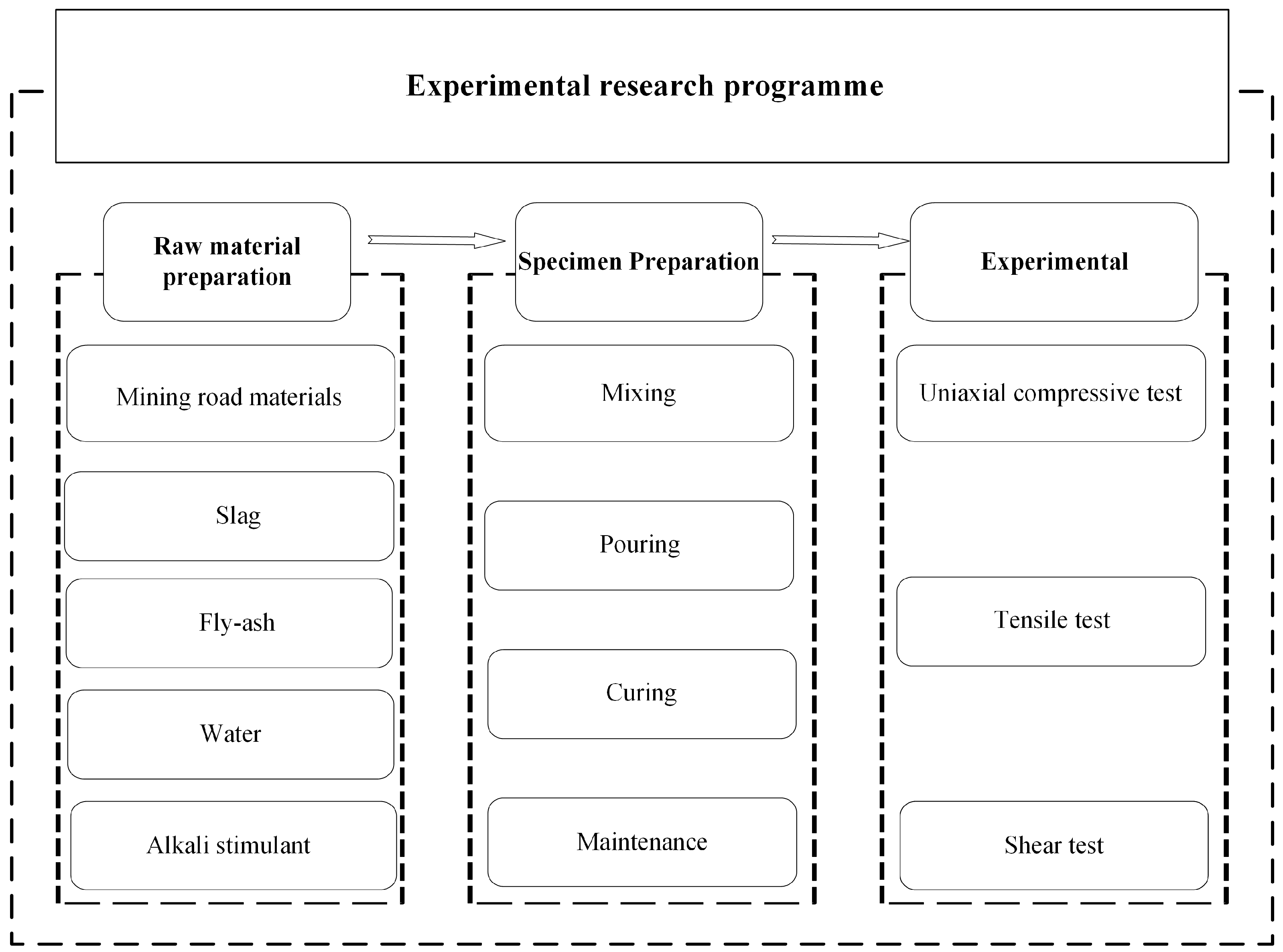



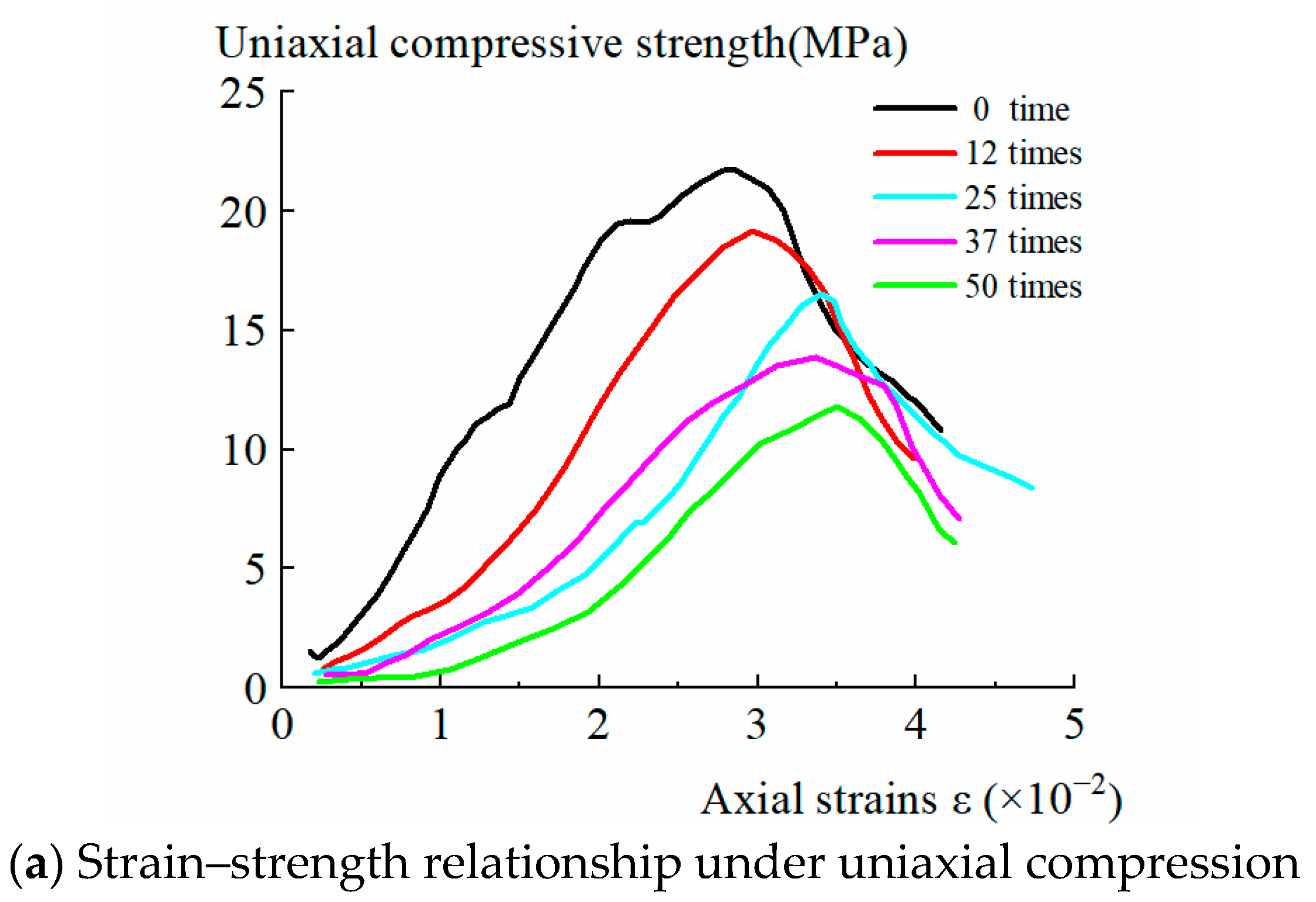
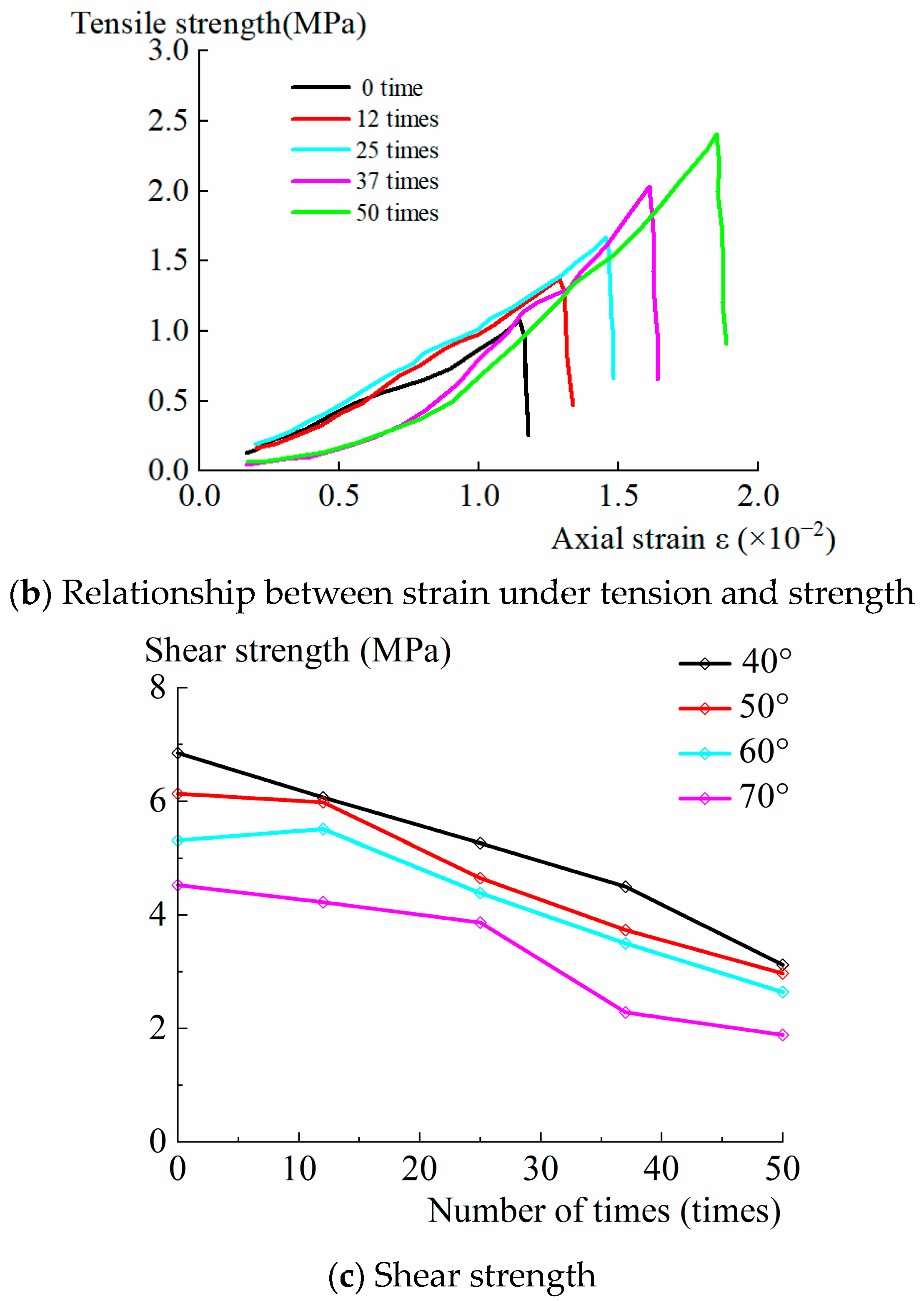
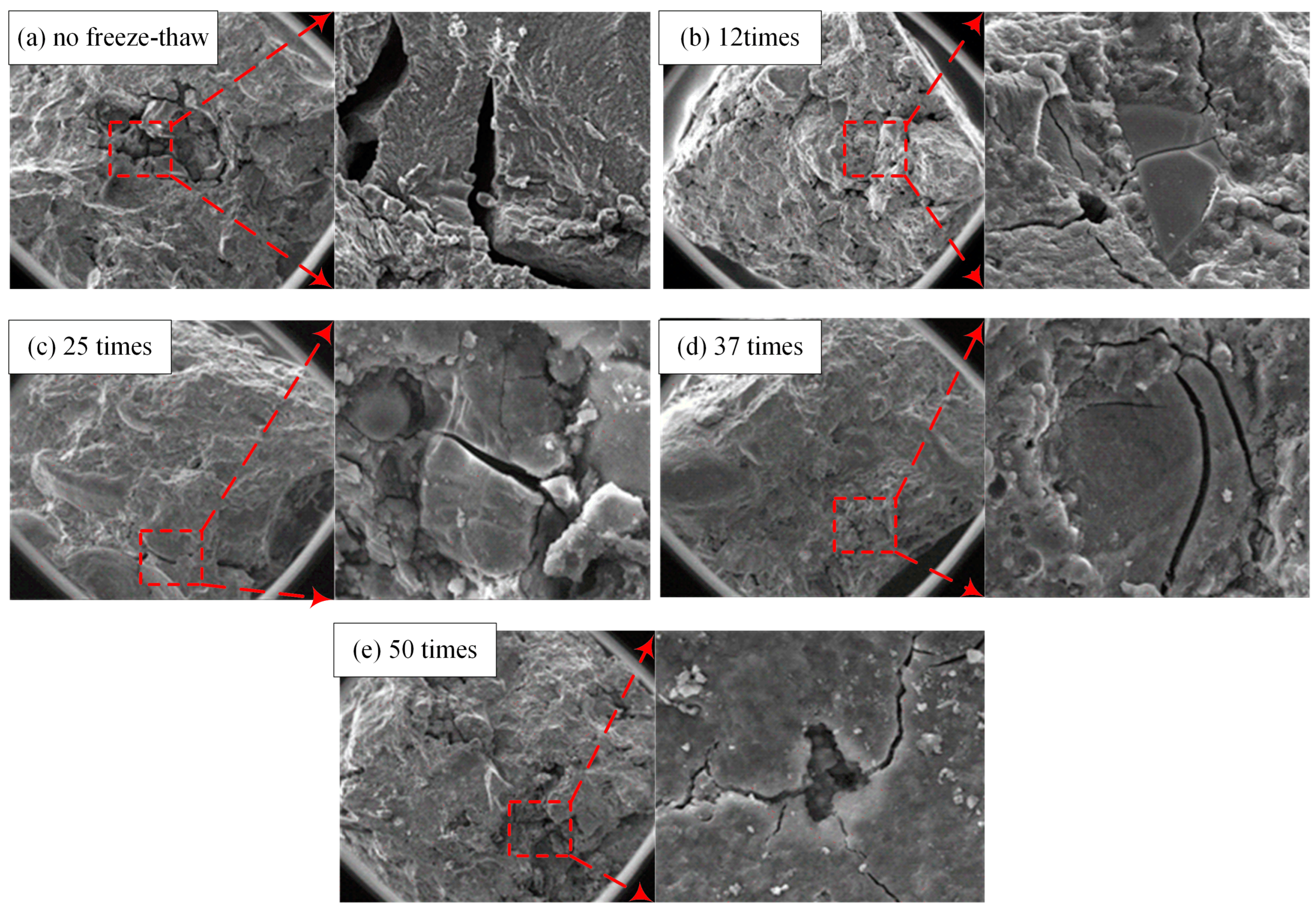
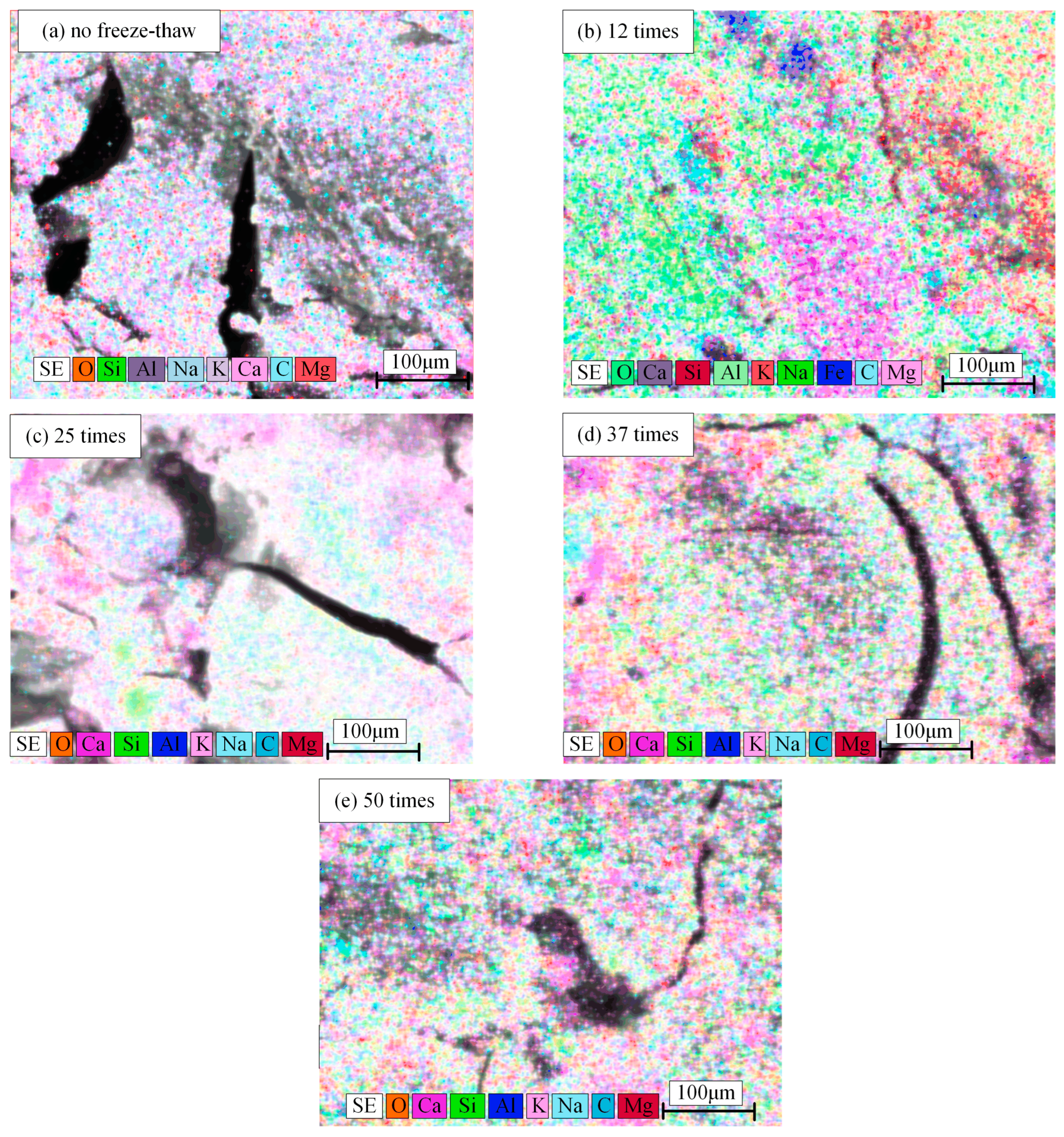


| Items | Capacity | Water Content | Cohesion | The Angle of Internal Friction |
|---|---|---|---|---|
| Parameters | 14.07 kN/m3 | 1.279% | 2.563 kPa | 36.32° |
| Caliber/mm | 0.15 | 0.3 | 0.6 | 1.18 | 2.36 | 4.75 | 9.5 | 16 | 19 | 26.5 | 31.5 |
| Mass/g | 2120 | 3940 | 3642 | 2898 | 4395 | 9413 | 10525 | 2798 | 4159 | 1581 | 1413 |
| Percentage % | 4.52 | 8.40 | 7.77 | 6.18 | 9.38 | 20.08 | 22.45 | 5.97 | 8.87 | 3.37 | 3.01 |
| Chemical Composition | CaO | SiO2 | Al2O3 | MgO | CO3 | TiO2 | S | Na2O | K2O | Others |
|---|---|---|---|---|---|---|---|---|---|---|
| Proportion | 36.76 | 28.36 | 15.29 | 8.31 | 7.75 | 1.15 | 0.99 | 0.43 | 0.32 | 0.64 |
| Chemical Composition | SiO2 | Al2O3 | CO3 | K2O | Fe2O3 | Na2O | CaO | MgO | TiO2 | Others |
|---|---|---|---|---|---|---|---|---|---|---|
| Proportion | 61.09 | 24.01 | 8.07 | 2.46 | 1.56 | 0.89 | 0.69 | 0.54 | 0.47 | 0.21 |
| Items | Modulus | Baume Degrees | SiO2% | Na2O% | Fe% | Water Insoluble Matter % | Solid Content % | Water Content % |
|---|---|---|---|---|---|---|---|---|
| Parameters | 3.38 | 39.5 | 26.13 | 8.25 | 0.02 | 0.2 | 34.6 | 65.4 |
Disclaimer/Publisher’s Note: The statements, opinions and data contained in all publications are solely those of the individual author(s) and contributor(s) and not of MDPI and/or the editor(s). MDPI and/or the editor(s) disclaim responsibility for any injury to people or property resulting from any ideas, methods, instructions or products referred to in the content. |
© 2023 by the authors. Licensee MDPI, Basel, Switzerland. This article is an open access article distributed under the terms and conditions of the Creative Commons Attribution (CC BY) license (https://creativecommons.org/licenses/by/4.0/).
Share and Cite
Lu, X.; Tu, L.; Tian, Y.; Zhou, W.; Zhao, X.; Yang, Y. Experimental Study of the Freeze–Thaw Damage of Alpine Surface Coal Mine Roads Based on Geopolymer Materials. Water 2023, 15, 3903. https://doi.org/10.3390/w15223903
Lu X, Tu L, Tian Y, Zhou W, Zhao X, Yang Y. Experimental Study of the Freeze–Thaw Damage of Alpine Surface Coal Mine Roads Based on Geopolymer Materials. Water. 2023; 15(22):3903. https://doi.org/10.3390/w15223903
Chicago/Turabian StyleLu, Xiang, Lixiao Tu, Ya Tian, Wei Zhou, Xinjia Zhao, and Yuqing Yang. 2023. "Experimental Study of the Freeze–Thaw Damage of Alpine Surface Coal Mine Roads Based on Geopolymer Materials" Water 15, no. 22: 3903. https://doi.org/10.3390/w15223903
APA StyleLu, X., Tu, L., Tian, Y., Zhou, W., Zhao, X., & Yang, Y. (2023). Experimental Study of the Freeze–Thaw Damage of Alpine Surface Coal Mine Roads Based on Geopolymer Materials. Water, 15(22), 3903. https://doi.org/10.3390/w15223903







